Table of Contents
Potassium is one of the three basic plant nutrients along with nitrogen and phosphorus. There is no substitute for potassium compounds in agriculture; they are essential to maintain and expand food production. Potash is found throughoul the world in both soluble and insoluble forms. Only the soluble forms are economically attractive to process, primarily as chlorides and sulfates, and potassium chloride is by far the most important potash salt. Sylvinite ore, a mechanical mixture of sylvite (KCl) and halite (NaCl), is a natural ore for potassium. This ore is found in commercial quantities in the Permian Basin region near Carlsbad, N. Mex. Vast tonnages of high-grade, low-clay-content ores have been mined and concentrated during the past 40 years; however, these deposits are rapidly bring depleted, leaving high-clay, low-grade ore reserves of over 735 million tons. These high-clay ores, containing 13 to 20 percent K2O and 3 to 7 percent clay slimes, cannot be effectively processed by current commercial flotation methods. The present concentration processes for potash minerals in Carlsbad relate mainly to ores containing 1 percent or less of clay-slimes with a K2O content of 18 to 25 percent that yield products meeting the requirements of the agriculture market; namely, 95 percent KCl, equivalent to 60 percent K2O.
Discoveries of potash ores in Saskatchewan, Canada, have shifted the emphasis to expansion outside the United States. Five of the seven companies operating near Carlsbad are producers of Canadian potash, despite the large investment sums required for shaft sinking and milling installations. Since Canadian potash has come on stream, production has overexpanded and there is every indication there will be a world surplus of potash for some years to come. However, the demand for potash is steadily increasing throughout the world, and the ultimate effect of the availability of potash from Canada will probably be to increase demand still further.
Despite the continuing economic pressure, there have been no permanent mine shutdowns in the Permian Basin, and the downward slide in the level of output has been halted. The Provincial Government of Saskatchewan, Canada, has instituted a conservation program to curb overproduction and maintain price stability. Even though supply and demand are being maintained in balance by artificial means, higher prices for potash have been introduced in place of previous levels, which were uneconomic for producers.
This development in turn has caused a greater interest in the processing of the reserves that contain the high-clay and low-grade ore in the New Mexico Permian Basin. The Bureau of Mines initiated studies to develop processes that would incorporate existing plant mechanical beneficiation equipment with minimum modifications. This paper presents the progress thus far in the Bureau-developed physical beneficiation processes for recovering potash minerals and in the development of ore-dressing systems that utilize flotation of the high-clay ores.
Description of the Ores
The high-clay low-grade sylvinite ores used in the investigations were obtained from the operating companies in the Permian Basin and contained 13 to 22 percent K2O and water insolubles of 1 to 7 percent. The chemical analyses of the four ores are given in table 1, and a screen analysis is shown in table 2.

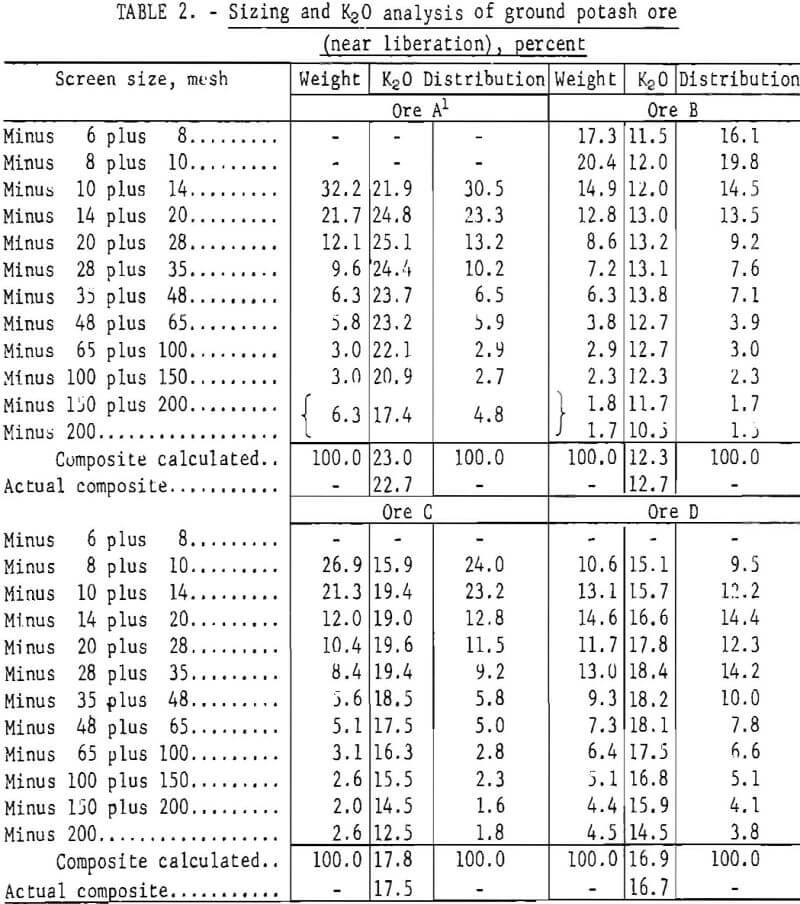
In the Carlsbad potash ores there is a free montmorillonite clay outside the crystals which is released by scrubbing the ore with saturated brine. Removal prior to flotation is essential because of the high absorptive power of the clay for the amines used as flotation reagents. The clay locked inside the crystals imparts a red color to the concentrate due to associated hematite, which is released only when the crystals are dissolved.
Standard methods of mineralogical analysis were used and static organic heavy liquid separation tests were conducted to characterize the minerals and provide liberation data. The results indicated that all of the ores were liberated between 10 and 14 mesh.
Experimental Conditions
Attrition and Slime Removal
Scrubbing techniques for the four ores were varied to obtain the best possible release of surface clay particles with minimum loss of potash fines to the sludge and minimum particle degradation. The variables included percent solids in the scrubber, speed of attrition, attrition time, single-stage and two-stage attrition, and washing the sample. The attrition speed was determined to be the governing factor that most affects the efficiency of desliming. Investigations proved that strenuous agitation in the scrubber produced excessive particle degradation and additional potash fines and clay slimes, which in turn adversely affected subsequent conditioning and flotation. A series of tests was run that determined a more moderate peripheral speed of the propellers to be necessary, in contrast to the general opinions that strenuous agitation is necessary to remove the clay slimes from the crystal surface. The test work led to the adoption of the following procedure:
The sample was scrubbed in saturated brine at 50 to 65 percent solids for 3 minutes using a Denver laboratory scrubber with a peripheral propeller speed of 770 fpm. The sample was wet-screened and washed at 200 mesh, and then subjected to an identical second scrubbing and washing cycle. This procedure effectively reduced the slime content of the ores to about 1 percent and increased the K2O content about 1.0 or 1.5 percent.
Conditioning
A series of conditioning tests was conducted on each of the four potash ores to determine optimum conditions for producing commercial-grade potash. The variables included conditioning speed, conditioning time, percent solids, and type and quantity of flotation reagents. The test work led to the adoption of the following procedure:
The deslimed sample was conditioned in an open tank-type conditioner in saturated brine at 70 percent solids for 2 minutes at slow speed (peripheral impeller speed 70 fpm). The most efficient collectors for potash are the high-molecular-weight acetate salts of aliphatic amines, particularly the octadecyl amine prepared from tallow. When floating ores coarser than 20 mesh, petroleum oils are added to increase the lifting power of the amine. Ore finer than 20 mesh is conditioned with a starch solution to reduce absorption of the amine by any clay still present.
Flotation
Laboratory test work, using a D-R Denver flotation cell, was done to determine the optimum pulp density, speed of agitation in rougher and cleaner flotation stages, and proper quantities of reagents. Results indicated that the potash floated best at 15 percent solids, with a peripheral speed of 935 fpm in the rougher and a peripheral speed of 575 fpm in the cleaner flotation cells. The most efficient flotation of the plus 20-mesh fraction was achieved by using 0.35 pound of Armac T and 0.5 to 0.6 pound of fuel oil per ton of ore. The minus 20-mesh fraction required 0.20 to 0.30 pound of Armac T and 0.50 to 1.0 pound of starch per ton of ore. A frother was added to the rougher cell in all test work.
The potash rougher flotation concentrate, while containing substantially all of the sylvite values, also contains fine entrained halite and locked sylvite-halite particles. Therefore, it is conventional mill practice to subject the rougher concentrate to a cleaner flotation operation. The resulting middling is usually treated by one of the following procedures:
- Recycle the middling to the conditioner and refloat in the rougher flotation cells.
- Screen the middling and recycle the coarser fraction to the conditioner and rougher flotation circuit. Combine the fine fraction with the rougher tailing.
- Screen the middling, regrind the coarser fraction, and recycle to the conditioner and rougher flotation circuit. Combine the fine fraction with the rougher tailing.
- Regrind the total middling, and recycle to the conditioner and rougher flotation circuit.
The manner in which the middling is processed is dependent on the grade of the cleaner concentrate and the characteristics of the ore. The laboratory-scale investigations have been adapted to meet these requirements.
Batch Flotation Tests on Potash Ores
Preliminary studies included batch testing of each ore to establish beneficiation techniques prior to conducting closed-circuit flotation tests that would simulate continuous operations, Variables included time, impeller
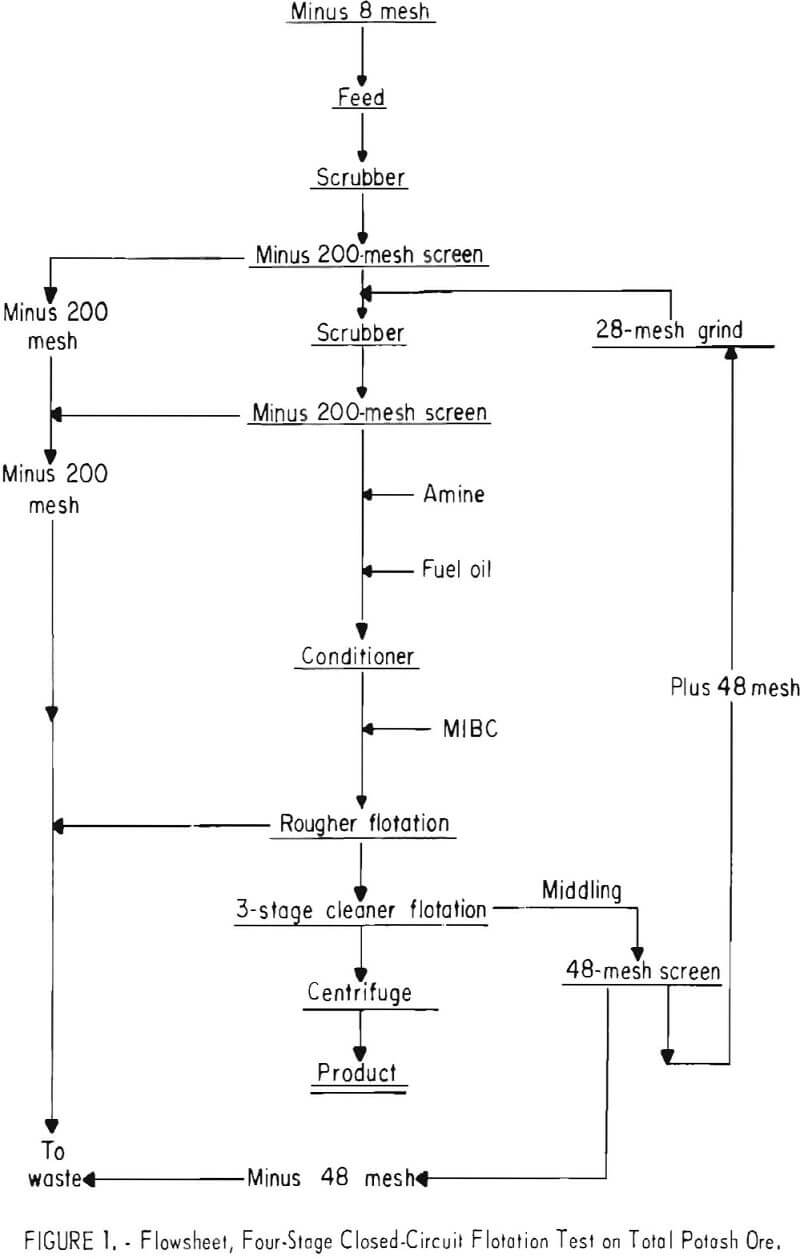

speeds, and percent solids in scrubbing, conditioning, and flotation of the four different ores. The flowsheets for these tests are identical to those shown in figures 1 and 2 except that middling products were not recycled. Reagent amounts and combinations were varied to obtain optimum grade and recovery and are the same as shown in tables 6 and 8. The results of these open circuit tests are shown in tables 3 and 4.

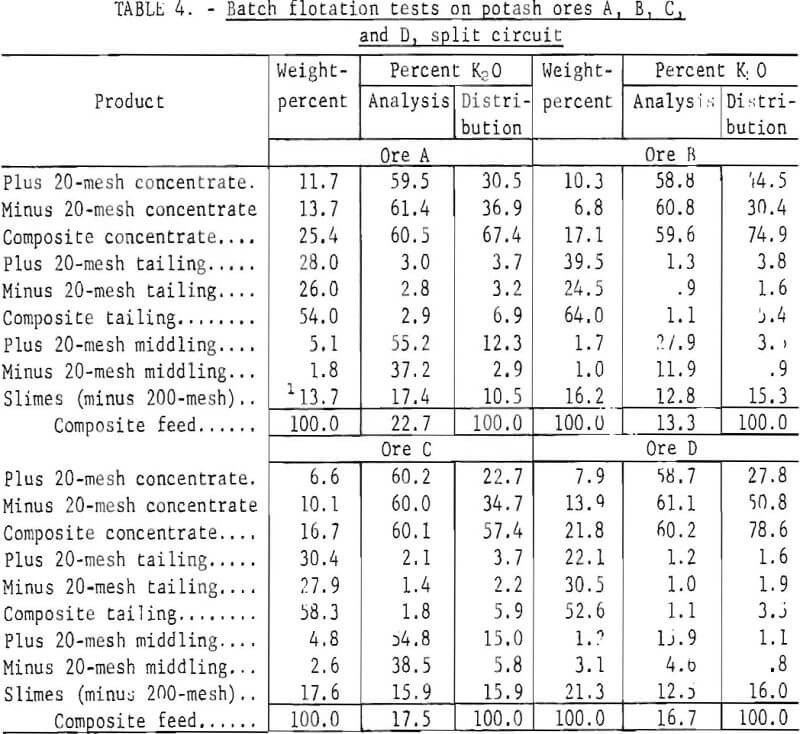
Closed-Circuit- Laboratory Flotation Tests On Potash Ores
Single-Circuit Total Ore Flotation Tests
Upon completion of preliminary studies, four-stage closed-circuit batch flotation tests were made to recirculate the middling product; and simulate continuous operations. A typical flowsheet of these experimental tests is shown in figure 1.
Four samples were ground to 8 mesh and subjected to two-stage scrubbing and desliming to remove the clay slimes. The deslimed ore was conditioned with Armac T and fuel oil flotation reagents at very high solids and floated with a frother in the rougher cell. The rougher concentrate was cleaned three times to produce a finished concentrate, which was removed from the circuit. The plus 48-mesh middling was ground to pass 28 mesh and added to the second-stage desliming step of the second sample. Tho minus 48-mesh middling was added to the rougher tailing. The second, third, and fourth samples were treated similarly, with the middling fractions being recycled to the succeeding feed samples. Only the plus 48-mesh portion of the middling from the fourth sample was saved for analysis. The four cleaner concentrates were combined to obtain a composite concentrate, and the four rougher tailings were combined to obtain a composite tailing. The results of the closed-circuit tests of the four different ores are shown in table 5. The reagent schedule for flotation of the four ores is shown in table 6.
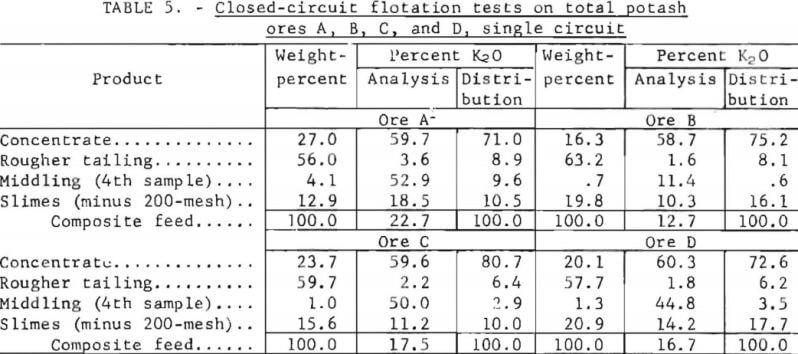

Split-Circuit Flotation Tests
By using a four-stage closed split circuit, product grade and recovery were improved over those attained in the single-circuit flotation tests.
Four samples were ground to 8 mesh and subjected to two-stage scrubbing and desliming to remove the clay. The samples were screened on 20 mesh, and the plus and minus 20-mesh fractions were conditioned and floated separately to obtain a rougher tailing that was removed from each circuit. The two rougher concentrates were each cleaned three times to produce a finished concentrate, which was also removed from each circuit. The plus 20-mesh middling was screened on a 20-mesh screen, ground to pass 20 mesh, and recycled to the second-stage scrubbing step of the minus 20-mesh circuit; the minus 20-mesh material was added to the rougher tailing. The middling from the minus 20-mesh circuit was screened on a 48-mesh screen, the plus 48 mesh was recycled to the conditioner, and the minus 48 mesh was added to the rougher tailing. The second, third, and fourth samples were treated similarly, with the middling fractions being processed and recycled to the succeeding feed samples. The four cleaner concentrates were combined to obtain a composite concentrate from each circuit, and the four rougher tailings were combined to obtain a composite tailing from both circuits. The plus 48-mesh portion of the middling from the fourth sample from the minus 20-mesh circuit was saved for analysis. A typical flowsheet of these experimental tests is shown in figure 2. The results of the closed split-circuit tests of the four ores are shown in table 7 with the reagent schedule shown in table 8.
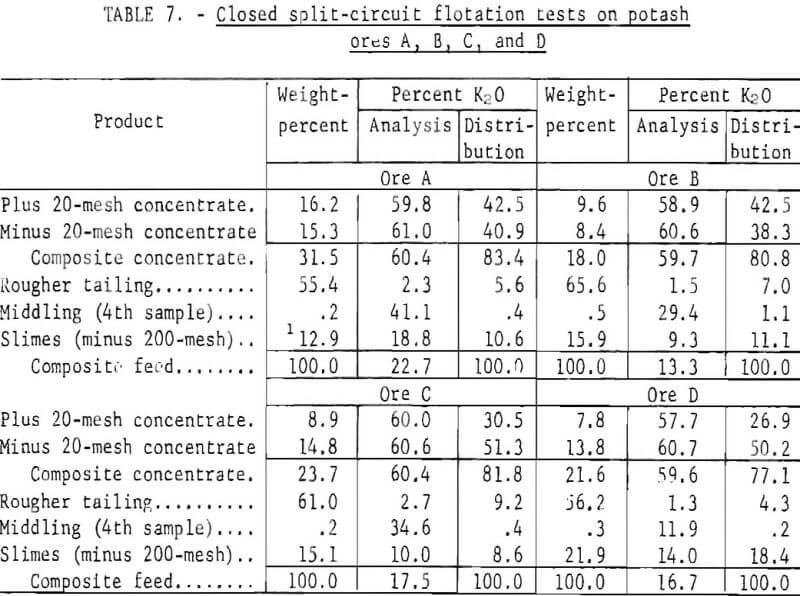

Flotation for Recovery of Granular and Coarse Potash Concentrates
Test work was oriented to include an open circuit flowsheet similar to that of figure 1 with the exception that the middling product would be a part of the feed to the present leach circuit, thereby eliminating regrinding and recycling of the middling.
Batch flotation tests were conducted on a selected minus 6- plus 20-mesh feed that contained 15.1 percent K2O and 4.1 percent water insolubles. The sample was subjected to two-stage attrition scrubbing and desliming to remove the clay slimes. The sample was conditioned with 0.35 pound of Armac T and 0.49 pound of fuel oil; then 0.08 pound of frother per ton of ore was added to the rougher cell. The rougher concentrate was floated and cleaned three times. The finished concentrate contained 59.5 percent K2O, and the middling 34.2 percent K2O. About 75 percent of the total K2O was recovered in the concentrate and 9 percent in the middling product. The cleaner concentrate was screened on a 14-mesh sieve to make the desired granular product, comprising 55.7 weight-percent of the material and containing 59.9 percent K2O. The remainder was minus 14-mesh material and contained 59.1 percent K2O. Research was conducted to determine the feasibility of producing, from one of the high-clay ores, a coarse, granular concentrate consisting of a mixture of minus 6- plus 14-mesh and minus 14- plus 20-mesh- two premium commercial grades.
Conclusions
The laboratory flotation tests demonstrated the technical feasibility of recovering commercial-grade potash products from the high-clay New Mexico ores that are not being processed at present. The research has provided a sound basis for the development of a beneficiation process. The next phase of the research will be devoted to continuous flotation processing to develop techniques for attrition scrubbing, desliming, and materials recycling on a larger scale.
